Conditions Necessary for Life
Earth is a unique planet. It is the only planet that we know of that has life. Not only does it have basic lifeforms like bacteria, it has very complex organisms like humans. What is so special about Earth anyway? Scientists agree there are 3 conditions necessary for life.
3 Conditions Necessary for Life
1. Comfortable distance from the Sun
This is often called the Goldilocks Zone. It means we're not too hot and we're not too close, we're just right. If the Earth was closer to the Sun, it would be too close and the temperatures too hot for most life to exist. If we were too far from the Sun, it would be too cold for most life to exist.
2. Liquid water
Many other planets and moons have water, but only Earth has liquid water. Water is liquid on Earth mostly because it's not too hot or too cold. Liquid water is necessary for plants and animals to drink and survive.
3. Free oxygen
Oxygen is a special element that allows living organisms to breathe. Without it, we would die. Other planets and moons have oxygen, but it's not free floating in the air. Usually it's trapped in rocks or combined with other elements in a very unusable form.
3 Conditions Necessary for Life
1. Comfortable distance from the Sun
This is often called the Goldilocks Zone. It means we're not too hot and we're not too close, we're just right. If the Earth was closer to the Sun, it would be too close and the temperatures too hot for most life to exist. If we were too far from the Sun, it would be too cold for most life to exist.
2. Liquid water
Many other planets and moons have water, but only Earth has liquid water. Water is liquid on Earth mostly because it's not too hot or too cold. Liquid water is necessary for plants and animals to drink and survive.
3. Free oxygen
Oxygen is a special element that allows living organisms to breathe. Without it, we would die. Other planets and moons have oxygen, but it's not free floating in the air. Usually it's trapped in rocks or combined with other elements in a very unusable form.
Inner Planets (Terrestrial)
Mercury
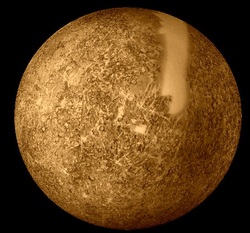
Mercury is the first planet in our solar system and closest to the Sun. Mercury is 57,909,175 kilometers from the Sun.
It is a very hot planet. It has daytime temperatures that can reach 800 degrees Fahrenheit. At night, the temperatures can drop to -290 degrees Fahrenheit.
Water boils at 212 degrees Fahrenheit and freezes at 32 degrees Fahrenheit, which means Mercury is hotter than boiled water during the day and colder than frozen water at night. So, water would have a difficult time staying on Mercury. However, there is water on Mercury. Trapped in frozen craters, water sits as ice until the Sun hits it and melts it. Water is not very usable in that icy form.
Another challenging factor about Mercury is its lack of atmosphere. There is not much of an atmosphere because it so close to the Sun that it burns most of the gases off. This means, if you lived on Mercury, it would be dark all the time. You could see the stars during the day and during the night.
It is a very hot planet. It has daytime temperatures that can reach 800 degrees Fahrenheit. At night, the temperatures can drop to -290 degrees Fahrenheit.
Water boils at 212 degrees Fahrenheit and freezes at 32 degrees Fahrenheit, which means Mercury is hotter than boiled water during the day and colder than frozen water at night. So, water would have a difficult time staying on Mercury. However, there is water on Mercury. Trapped in frozen craters, water sits as ice until the Sun hits it and melts it. Water is not very usable in that icy form.
Another challenging factor about Mercury is its lack of atmosphere. There is not much of an atmosphere because it so close to the Sun that it burns most of the gases off. This means, if you lived on Mercury, it would be dark all the time. You could see the stars during the day and during the night.
Venus
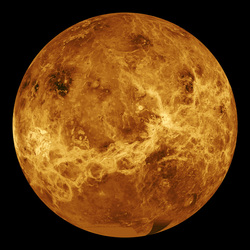
The second planet from the Sun, Venus is far enough away from the Sun that it could potentially hold life. It would definitely be warmer than Earth, but still not too bad. Venus is108,208,930 kilometers from the Sun.
Even though Venus is in a decent location, it has other factors working against it. For starters, Venus revolves so slowly that it cannot generate a very strong magnetic shield around the planet, which means that harmful radiation from the Sun would regularly hit the planet.
Secondly, Venus has an extremely thick atmosphere of carbon dioxide and sulfuric acid -- both of which are too toxic to most life. There are small amounts of water vapor, but not enough to support life. The atmosphere is so thick that the planet is almost always covered in clouds. These clouds drop acid rain to the surface. The clouds also create what's known as the Greenhouse Effect, which means the heat from the Sun tries to escape back into space, but cannot because the clouds trap it in. This makes the surface of Venus way too hot for life to exist. Temperatures can reach 864 degrees Fahrenheit, much too hot for liquid water to exist without turning into water vapor.
Even though Venus is in a decent location, it has other factors working against it. For starters, Venus revolves so slowly that it cannot generate a very strong magnetic shield around the planet, which means that harmful radiation from the Sun would regularly hit the planet.
Secondly, Venus has an extremely thick atmosphere of carbon dioxide and sulfuric acid -- both of which are too toxic to most life. There are small amounts of water vapor, but not enough to support life. The atmosphere is so thick that the planet is almost always covered in clouds. These clouds drop acid rain to the surface. The clouds also create what's known as the Greenhouse Effect, which means the heat from the Sun tries to escape back into space, but cannot because the clouds trap it in. This makes the surface of Venus way too hot for life to exist. Temperatures can reach 864 degrees Fahrenheit, much too hot for liquid water to exist without turning into water vapor.
Earth
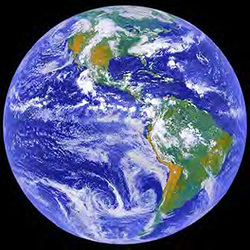
Earth is a special planet. The third planet from the Sun, it is the perfect distance away: not too hot and not too cold. Its distance is 149,597,890 kilometers from the Sun. The average temperature on Earth is about 35 degrees Celsius, or about 95 degrees Fahrenheit.
Earth's atmosphere is composed of nitrogen, oxygen, water vapor, carbon dioxide and other small amounts of gases. It is the perfect mix of gases to support life.
Because Earth has comfortable temperatures, liquid water exists on Earth. Not only does it exist, there is a LOT of it. In fact, 71 percent of the Earth is covered in water. That's a lot of water to support a lot of life.
Earth's atmosphere is composed of nitrogen, oxygen, water vapor, carbon dioxide and other small amounts of gases. It is the perfect mix of gases to support life.
Because Earth has comfortable temperatures, liquid water exists on Earth. Not only does it exist, there is a LOT of it. In fact, 71 percent of the Earth is covered in water. That's a lot of water to support a lot of life.
Mars
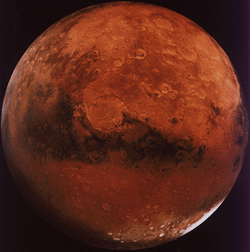
Smaller than Earth, Mars is much further away, resting at 227,936,640 kilometers away from the Sun.
Though the red surface of Mars looks like it would be a hot, dry dessert, the opposite is true. Mars is a very cold planet, with temperatures reaching only 23 degrees Fahrenheit at the hottest during the summer and -125 degrees Fahrenheit during the winter. The hottest temperature is not too cold for life to exist, but it would be very difficult for most organisms to survive.
Even if life could live on Mars, it would have a difficult time finding liquid water. Because the hottest temperature on Mars is colder than the temperature at which water freezes, all the water on Mars is frozen. There is a good amount of frozen water on Mars. Most of this is trapped in ice sheets at the poles. This is similar to Earth, which makes sense because Mars has a similar planet tilt, which means Mars has similar seasons to Earth. Mars even has snow during the winter.
Mars' atmosphere is made up of carbon dioxide, nitrogen and argon. These elements are also in Earth's atmosphere, but there isn't enough nitrogen and oxygen is still missing. If humans lived on Mars, they would have to wear space helmets all the time to still breathe.
Though the red surface of Mars looks like it would be a hot, dry dessert, the opposite is true. Mars is a very cold planet, with temperatures reaching only 23 degrees Fahrenheit at the hottest during the summer and -125 degrees Fahrenheit during the winter. The hottest temperature is not too cold for life to exist, but it would be very difficult for most organisms to survive.
Even if life could live on Mars, it would have a difficult time finding liquid water. Because the hottest temperature on Mars is colder than the temperature at which water freezes, all the water on Mars is frozen. There is a good amount of frozen water on Mars. Most of this is trapped in ice sheets at the poles. This is similar to Earth, which makes sense because Mars has a similar planet tilt, which means Mars has similar seasons to Earth. Mars even has snow during the winter.
Mars' atmosphere is made up of carbon dioxide, nitrogen and argon. These elements are also in Earth's atmosphere, but there isn't enough nitrogen and oxygen is still missing. If humans lived on Mars, they would have to wear space helmets all the time to still breathe.
Outer Planets (Gaseous)
Jupiter
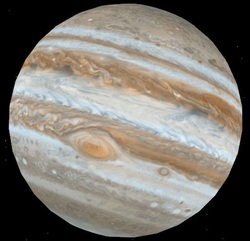
Jupiter is the king of the planets in the solar system. It is more massive than all the other planets. It is the first of the outer, gas giants. With its large size and the largest magnetic shield in the solar system, it seems like it could support life, but it has a lot of things working against it.
For starters, it is 778,412,020 kilometers away from the Sun -- more than five times the distance of the Earth from the Sun. Because of its distance, Jupiter is a cold world, averaging a temperature of -234 degrees Fahrenheit. This is too cold for water to exist in a liquid form.
Jupiter's atmosphere is made of hydrogen and helium, the same elements that make up the Sun. These elements are not supportive to life. Because of its massive size, the hydrogen turns into liquid hydrogen and metal hydrogen further down toward the center of the planet.
For starters, it is 778,412,020 kilometers away from the Sun -- more than five times the distance of the Earth from the Sun. Because of its distance, Jupiter is a cold world, averaging a temperature of -234 degrees Fahrenheit. This is too cold for water to exist in a liquid form.
Jupiter's atmosphere is made of hydrogen and helium, the same elements that make up the Sun. These elements are not supportive to life. Because of its massive size, the hydrogen turns into liquid hydrogen and metal hydrogen further down toward the center of the planet.
Saturn

Most famous for its rings, Saturn is a massive planet. It is the second largest in the solar system. It is 1,426,725,400 kilometers away from the Sun, or about 9.5 times further than the Earth from the Sun.
Saturn has an average temperature of -288 degrees Fahrenheit, which makes it only slightly colder than Jupiter. Like Jupiter, Saturn has a powerful magnetic field, which is more than 500 times more powerful than Earth's. However, the atmosphere of Saturn is made of hydrogen and helium. There does not appear to be any liquid water on Saturn.
Saturn has an average temperature of -288 degrees Fahrenheit, which makes it only slightly colder than Jupiter. Like Jupiter, Saturn has a powerful magnetic field, which is more than 500 times more powerful than Earth's. However, the atmosphere of Saturn is made of hydrogen and helium. There does not appear to be any liquid water on Saturn.
Uranus
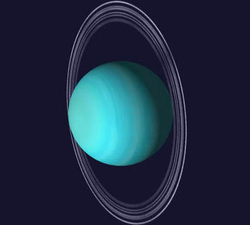
Uranus is a strange, misunderstood planet. For starters, it is tilted on its side. It is a gas giant, but much smaller than Jupiter or Saturn. Still, its volume is 63 times bigger than Earth.
Uranus is 2,870,972,200 kilometers away from the Sun, or about 19 times further away from the Sun than the Earth. Its average temperature is -357 degrees Fahrenheit, making it much colder than Jupiter or Saturn. It is also the coldest planet in the solar system.
The atmosphere of Uranus is made of hydrogen, helium and methane. Small amounts of water vapor exist in the atmosphere as well. The core of Uranus is frozen water and methane and ammonia, which would not be useful to life because ammonia is toxic to most lifeforms.
Uranus is 2,870,972,200 kilometers away from the Sun, or about 19 times further away from the Sun than the Earth. Its average temperature is -357 degrees Fahrenheit, making it much colder than Jupiter or Saturn. It is also the coldest planet in the solar system.
The atmosphere of Uranus is made of hydrogen, helium and methane. Small amounts of water vapor exist in the atmosphere as well. The core of Uranus is frozen water and methane and ammonia, which would not be useful to life because ammonia is toxic to most lifeforms.
Neptune
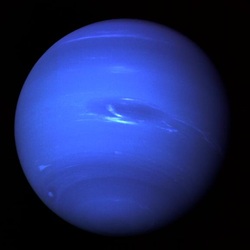
Neptune is a blue, gaseous, outer planet that is the eighth from the sun. It is 4,498,252,900 kilometers from the Sun, or 30 times more distant from the Sun than Earth.
It has an average temperature of -353 degrees Fahrenheit.
Like Uranus, its atmosphere is made up mostly of hydrogen, helium and methane. However, Neptune does have a frozen water core.
It has an average temperature of -353 degrees Fahrenheit.
Like Uranus, its atmosphere is made up mostly of hydrogen, helium and methane. However, Neptune does have a frozen water core.
